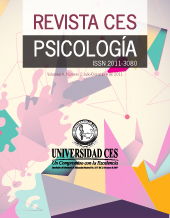Racial Prejudice among Children of Early Childhood Education: Revisiting Clark & Clark (1947)
DOI:
https://doi.org/10.21615/cesp.13.2.3Keywords:
Early Childhood Education, Racial Prejudice, Intergroup RelationsAbstract
The racial prejudice among children is an extremely important issue in exploring the genesis of this social virus. However, few researchers in Brazil were interested in the subject. The main objective of this paper is to replicate the classic Clark and Clark´s experiment (1947). Ninety-nine children from Paraíba, black (51) and white (48) participated. About 86.9% of the children chose the white doll to play with; 78.8% of the children considered the white doll as the good one; 76.8% chose the black doll as the bad one; 92.9% of the children considered the white doll as the nice one; 84.8% of the children indicated that the white doll looks like them; 85.9% stated that they would do academic activity with the white doll. The main results denounce the color prejudice in children in the school environment. More studies are expected to highlight racial prejudice among school-age children, highlighting the role of the media, the family and the school.
Downloads
References
Aboud, F. (1998). The developmental psychology of racial prejudice. Transcultural Psychiatric Research Review, 30, 229-242. doi: http://dx.doi.org/10.1007/978-3-030-12228-7_2
Allport, G. W. (1954). The nature of prejudice. Reading, MA: Addison-Wesley.
APA. (2015). American Psychological Association. Glossary of psychological terms. Recuperado em: http://www.apa.org/research/action/glossary.aspx?tab=17
Aranha, M.L.A. (1993). Maquiavel - A lógica da força. São Paulo: Moderna.
Asher, S. R, & Allen, V. L. (1969). Racial preference and social comparison processes. Journal of Social Issues, 25, 157-167. doi: http://dx.doi.org/10.1111/j.1540-4560.1969.tb02584
Brown, R. (2010). Prejudice: It’s social psychology. UK: Wiley-Blackwell.
Bento, M. A. S. (2002). Branqueamento e branquitude no Brasil. In I. Carone & M. A. S. Bento (Eds.). Psicologia social do racismo: Estudos sobre branquitude e branqueamento no Brasil (pp. 25-57). Petrópolis: Vozes.
Carneiro, M. L. T. (1998). O racismo na história do Brasil: Mito e realidade. São Paulo: Ática.
Clark, K. B., & Clark, M. P. (1947) Racial identification and preference in negro children. In H. Proshansky & B. Seidenberg (Eds.), Basic Studies in Social Psychology (pp. 308–317). New York: Holt Rinehart and Winston.
Corenblum, B., & Annis, R. C. (1993). Development of racial identity in minority and majority children: An affect discrepancy model. Canadian Journal of Behavioral Science, 19, 254-265. doi: http://dx.doi.org/10.1037/h0078858
Junior, H. S., Bento, M. A. S., & Carvalho, S. P. (2012). Educação infantil e práticas promotoras de igualdade racial. São Paulo: Centro de Estudos das Relações de Trabalho e Desigualdades - CEERT: Instituto Avisa lá - Formação Continuada de Educadores.
Fanon, F. (2008). Pele negra máscaras brancas. Rio de Janeiro: Editora Fator.
Fernandes, S.C.S., Almeida, S.S.M., & Nascimento, C.B.S. (2008). Análise do preconceito racial em uma amostra de crianças brancas de 5 a 8 anos de idade. PSICO, Porto Alegre, 39, (4), 441-447. Recuperado em: https://dialnet.unirioja.es/servlet/articulo?codigo=5161537
Fernandes, F. (1978). A integração do negro na sociedade de classes. São Paulo: Ática.
França, D. X., & Monteiro, M. B. (2002). Identidade racial e preferência em crianças brasileiras de 5 a 10 anos. Psicologia, 16(2), 293-323. doi: http://dx.doi.org/10.17575/rpsicol.v16i2.482
França, D.X., & Monteiro, M. B. (2011). Identidade racial e atitudes para o próprio e outro grupo em crianças. In S. C. S. Fernandes, C. E. Pimentel, V. V. Gouveia, & J. L. Álvaro. (Eds.). Psicologia social: perspectivas atuais e evidências empíricas (p. 86-113). São Paulo: Casa do Psicólogo.
Fanon, F. (2008). Pele negra, máscaras brancas. Bahia: Editora Edufba.
Garcia, C. (setembro de 2005). 120 Barbies são vendidas por minuto. Folha de São Paulo, São Paulo.
Guimarães, A.S.A. (2004). Preconceito de cor e racismo no Brasil. Revista de Antropologia, 47(1), 9-43. doi: http://dx.doi.org/10.1590/S0034-77012004000100001
Hirschefeld, A. (1996). Race in making: Cognition, culture and the child’s construction of human kinds. Massachusetts. A Bradford Book.
Katz, P.A. (1976). The acquisition of racial attitudes in children. In P.A. Katz (Ed.), Towards the elimination of racism (pp. 125-154). New York: Pergamon Press.
Katz, P.A. (1983). A review of recent research in children’s racial attitude acquisition. In L. Katz (Ed.), Current topics in early childhood education (pp. 17-54). Norwood, NJ: Ablex.
Levy, S.R., Rosenthal, L., & Herrera-Alcazar, A. (2010). Racial and ethnic prejudice among children. In J.L. Chin (Ed.), The psychology of prejudice and discrimination (pp. 37-50). Westport, Connecticut: Praeger.
Lima, M.E.O., & Vala, J. (2004). As novas formas de expressão do preconceito e do racismo. Estudos de Psicologia (Natal), 9(3), 401-411. doi: http://dx.doi.org/10.1590/S1413-294X2004000300002
Máximo, T.A.C., Larraian, L.F.C., Nunes, A.L.L., & Lins, S.L. (2012). Processos de identidade social e exclusão racial na infância. Psicologia em Revista (Online), 18, 507-526. doi: http://dx.doi.org/10.5752/P.1678-9563.2012v18n3p507
Milner, D. (1973). Racial identification and preference in black British children. European Journal of Social Psychology, 3, 281-295. doi: http://dx.doi.org/10.1002/ejsp.2420030307
Milner, D. (1993). Children and race: Ten years ago. London: Alan Sutton.
Nelson, T.D. (2009). The handbook of prejudice, stereotyping, and discrimination. UK: Psychology Press.
Oliveira, I. (1998). As desigualdades raciais vistas pelas crianças e pelos jovens. Dissertação de Mestrado Não-Publicada em Psicologia Escolar e do Desenvolvimento Humano. Instituto de Psicologia, Universidade de São Paulo, São Paulo.
Paré, M. L. (2000). Autoimagem e autoestima na criança negra: Um olhar sobre o seu desempenho escolar. Dissertação de Mestrado Não-Publicada em Educação. PUC/Rio grande do Sul. Porto Alegre.
Pérez-Nebra, A.R., & Jesus, J.G. (2011). Preconceito, estereótipo e discriminação. In C.V. Torres & E.R. Neiva (Eds.), Psicologia social: Principais temas e vertentes (pp. 219-237). Porto Alegre, RS: ArtMed.
Ramsey, P. G. (1987). Young children's thinking about ethnic differences. In J. Phinney & M. J. Rotherman, (Eds.), Ethnic socialization of children (pp. 32-55). Beverly Hills: Sage Publications.
Rodrigues, A., Assmar, E.M.L., & Jablonski, B. (2012). Psicologia social. Petrópolis: Vozes.
Roland, E. (2001). Gênero e raça e a promoção da igualdade. Brasília: TEM Acessoria Internacional.
Secretaria de Educação Fundamental de Brasil (1997). Parâmetros Curriculares Nacionais: apresentação dos temas transversais, ética. Secretaria de Educação Fundamental-Brasília: MEC/SEF.
Silva, P., Pereira, A., & Camino, L. (2002). O desenvolvimento racial e o processo de branqueamento em crianças. In: VI CCHLA. Conhecimento em Debate. [CD-ROM]. João Pessoa: Editora da Universidade Federal da Paraíba.
Silva, L. R. (2018). Não me chame de mulata: uma reflexão sobre a tradução em literatura afrodescendente no Brasil no par de línguas espanhol-português. Trabalhos Em Linguística Aplicada, 57(1), 71-88. Recuperado de https://periodicos.sbu.unicamp.br/ojs/index.php/tla/article/view/8651618
Tajfel, H. (1978). Social categorization, social identity and social comparison. In: H. Tajfel. (Ed.). Differentiation between groups (pp. 61-76). London: Academic Press.
Turra, C., & Venturi, G. (1995). Racismo cordial: A mais completa análise sobre preconceito de cor no Brasil. São Paulo: Ática.
Weschenfelder, V. I., & Silva, M. L. D. (2018). A cor da mestiçagem: o pardo e a produção de subjetividades negras no Brasil contemporâneo. Análise Social, (227), 308-330. doi: http://dx.doi.org/10.31447/AS00032573.2018227.03
Downloads
Published
How to Cite
Issue
Section
License
Copyright (c) 2020 CES Psicología

This work is licensed under a Creative Commons Attribution-NonCommercial-ShareAlike 4.0 International License.
Each manuscript is accompanied by a statement specifyingThat the materials are unpublished, that have not been previously published in printed formatElectronic and that they will not be presented to any other means before knowing the decision of the magazine. ThroughoutIn case, any previous publication, sea in printed or electronic form, must be made known to the editorial staffWriting The authors attach a signed statement stating that, and the manuscript is acceptedFor publication, the rights of reproduction are the exclusive property of the Journal CES Psychology.| Article metrics | |
|---|---|
| Abstract views | |
| Galley vies | |
| PDF Views | |
| HTML views | |
| Other views | |




